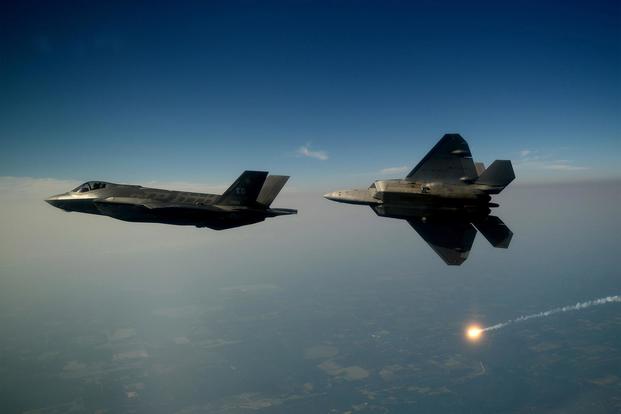The U.S. Air Force plans to conduct additional tests at its combatant commands of a sophisticated data-sharing system that fuses intelligence data from multiple platforms, according to top service officials.
Dr. Will Roper, assistant secretary of the Air Force for acquisition, technology and logistics, and Preston Dunlap, the service's chief architect for the Advanced Battle Management System (ABMS), explained Tuesday that developers went to U.S. Northern Command first for key tests to see if the military services could execute multi-domain operations by pooling resources.
In one case, it included a highly publicized F-22 Raptor and F-35 Joint Strike Fighter data transfer test, conducted in December off the coast of Florida.
"We did begin to pass data back and forth over what we call a low-probability-of-detection intercept," said Dunlap, adding that the test involved Air Force fifth-generation fighters and Navy F-35Bs transferring data securely.
Related: In First, Air Force Will Send Secure Data Between an F-22 and F-35
The F-22 was built with a datalink -- Intra-Flight Data Link, or IFDL -- system that is incompatible with the F-35's Multi-Function Advanced Datalink system, or MADL. So the F-22 can receive data from the F-35 and fourth-generation fighters through its legacy Link 16 system, but cannot share data back. Link 16 is the standard U.S. and NATO operating system.
That experiment tested a solution built by Lockheed Martin, Northrop Grumman and Honeywell: "GatewayONE," a radio and antenna system.
In a forthcoming test scheduled for April, testers plan to insert the gateway into the Kratos XQ-58 Valkyrie drone, which the service is experimenting with for its Loyal Wingman and Skyborg programs. The Air Force may also use another airborne drone platform, Roper said.
According to Dunlap, recent tests included linking the SpaceX Starlink commercial Internet system to an AC-130 gunship "to move data back and forth;" moving command-and-control operations to a cloud system; and managing a battlespace, situational awareness operation from a forward location instead of a fixed location.
Future tests will harness the functions of Space Command and Strategic Command, the officials said.
"We're going to be emphasizing, especially with the creation of the Space Force and U.S. Space Command ... we will have a significant Space Command-focused and Space Force-focused portion of the scenario in concert with Northern Command, as well as beginning to introduce U.S. Strategic Command into the mix," Dunlap said.
Roper said testers had a low baseline for success: Roughly a 10% success rate would have been enough.
But in the Northern Command exercise, Roper said he was "thrilled" that 26 test points out of 28 worked. "That's too high of the success rate this first time, but I'll take it," he said.
Air Force Gen. Terrence O'Shaughnessy, head of NORTHCOM and North American Aerospace Defense Command (NORAD), and Deputy Secretary of Defense David Norquist were able to witness how the decision-making process could be streamlined. Instead of a multitude of phone calls between top officials on minute-by-minute developments, "people are no longer the glue," Roper said.
"The information flows everywhere all at once, and the people are the assessors, the analyzers, the feedback providers," he said.
The success of the ABMS tests should prompt defense companies to compete to reconfigure older, legacy systems that could one day connect to a larger network to give service members data and intelligence in real-time, Roper said.
"What I hope industry will see in the Advanced Battle Management System program is a pot of money that is for connecting things, both new things and legacy things, and that it is open for competition," he said.
ABMS will get better -- especially through the use of automation and artificial intelligence built into the system -- as it self-corrects and learns over time, Roper said.
"Sometimes, when we talk about command and control, the control sounds like building a system that tells you what to do. And that's really not what ABMS is about," he said. "Very similar to the way the app 'Waze' works, it's [about] helping you be a better driver. … It understands your likes and dislikes, and it's pulling information from the world around you.
"The more you interact with the app, the better the analytics get," he said.
-- Oriana Pawlyk can be reached at oriana.pawlyk@military.com. Follow her on Twitter at @Oriana0214.
Read more: Space Development Agency Director Outlines Plan to Join Space Force













